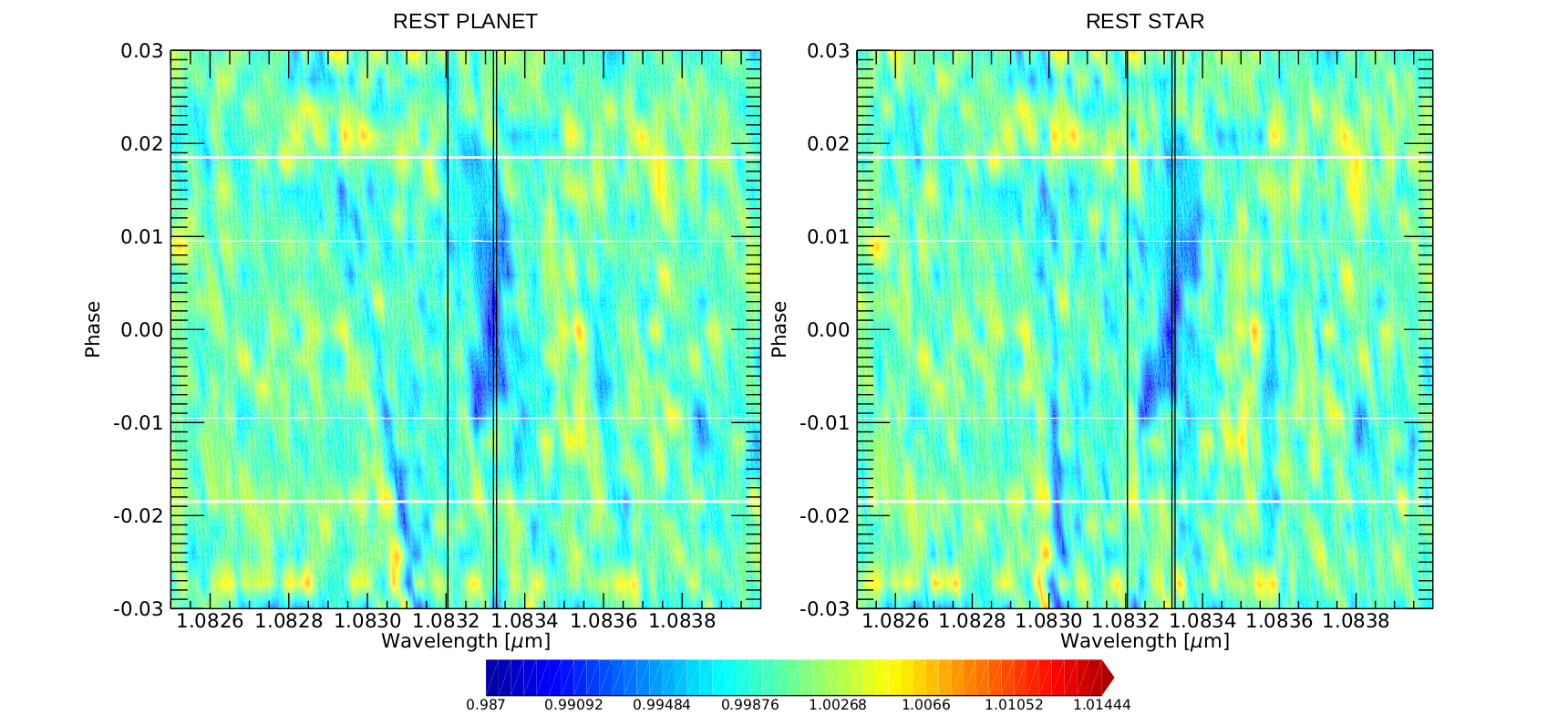The GIARPS view of the extended helium atmosphere of HD189733 b accounting for stellar activity
HD 189733b is one of the most studied exoplanets to date. It has a mass slightly bigger (~13%) than that of Jupyter and orbits around its host star with a period of 2.2 days. Due to the proximity to the parent star, HD 189733b is heated to a temperature of about 1200 K, making it a hot-Jupiter.
Hot Jupiters orbiting very close to their host stars are subject to intense X-ray and extreme ultraviolet irradiation received from the star that lead the gas content in the upper atmospheric layers to heat and to expand. The gas fraction with a velocity greater than the escape velocity can then overcome the planetary force of gravity, escaping into space. The study of extended or in-evaporation atmospheres is a very interesting topic in the exoplanetary field. For example, atmospheric evaporation processes, driving strong mass-loss, could be responsible for the paucity of intermediate-mass/size (sub-Jovian) planets with periods lesser than 3 days (the so-called 'Neptunian desert').
An international team, led by Italian researchers of the GAPS (Global Architecture of Planetary Systems) collaboration, studied the extended atmosphere of HD 189733b in search of helium. Helium, as it is very light and abundant in the atmosphere of giant planets, is an excellent tracer for atmospheric evaporation. A direct way to understand if the planet is surrounded by an extended atmosphere is looking at an atomic helium transition in the near-infrared (around 1083.3 nm, vacuum wavelength). Five transit events of HD 189733b have been observed using the GIARPS (GIANO-B+HARPS-N) observing mode of the Telescopio Nazionale Galileo.
The employed technique is 'transmission spectroscopy'. By comparison of the out-of-transit (the stellar spectrum, without the planetary contribution) and in-transit (i.e. stellar+planetary spectrum) observations, this method allows highlighting a possible signal due to the planetary atmosphere. With this technique, the helium signal has been spectrally resolved and detected during all five transits. The attached figure shows the helium signal (in blue) in the planetary rest frame (left panel) and in the stellar rest frame (right panel) obtained by combining the 5 transits. Thanks to the high spectral resolution of GIANO-B, it is possible to establish that, as the signal is aligned in the planetary rest-frame, we are observing a signal due to the planet's atmosphere, and not related to stellar variability. Moreover, the researchers detected night-to-night variations in the helium absorption signal likely due to the transit events occurring in the presence of stellar surface inhomogeneities.
HD 189733 is a very active star that shows both active and quiescent magnetic regions that change their positions from one observation to the next. The occultation during transit of these regions can lead to stellar-activity pseudo-signals in the position of the helium line that can interact with the planetary signal, mimic both emission and absorption. Distinguish between the real planetary contribution and the stellar pseudo-signals is a very important task. Indeed if we do not perform this operation, we can give a wrong interpretation to the extended exo-atmosphere.
To better understand the true atmospheric signal the researchers performed a comparative analysis of the helium line (with GIANO-B) and other diagnostics of stellar activity in the visible (thanks to HARPS-N), as the Hα line. In the active regions, the helium line and the Hα have an opposite behaviour, the more intense the first, the less intense the second. In this way, the true planetary signal can be distinguished from the pseudo-signals induced by stellar activity. Once the stellar-activity contribution has been eliminated, researchers realized that HD 189733b has an extended helium atmosphere, but, as it has a small mass-loss rate, it is not in evaporation.

Transmission spectra shown in tomography in the planetary (left) and stellar (right) rest frame, as a function of the wavelength and the orbital phase (transmission spectra are binned both in wavelength and in phase). An excess absorption (in blue) is present during the transit at the position of the helium transition around 1083.3 nm. The contact point t1, t2, t3 and t4 are marked with horizontal white lines. The high spectral resolution of GIANO-B allows us to conclude that the helium signal is aligned in the planet's rest frame, thus it is not related to stellar activity.
Related paper:
Guilluy, G., et al., A&A in press, https://arxiv.org/abs/2005.05676

